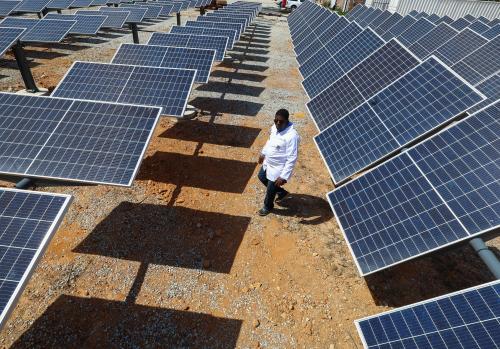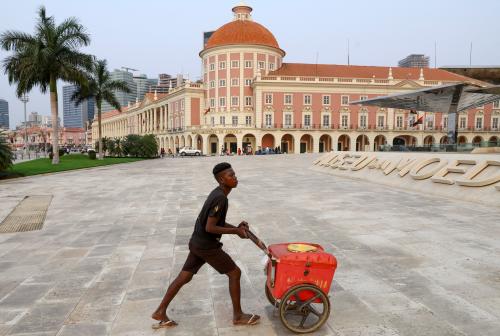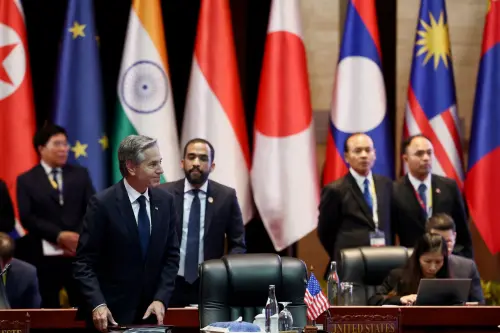Data in this commentary was updated on July 22, 2009.
China recently announced that its stock of foreign exchange reserves crossed the astounding milestone of $2 trillion in April 2009. China has accumulated a larger stockpile of reserves than any other country. It accounts for nearly 30 percent of all reported foreign exchange reserves, almost quadruple its share of 8 percent in 2001 (Table 1). The financial crisis hit the pace of reserve accumulation, which slowed to a crawl in the last quarter of 2008, but reserve growth has recently taken off again.
Reported foreign exchange reserves do not include amounts shifted to the balance sheets of state commercial banks or entities other than the People’s Bank of China. Hence, the precise level of reported reserves is not very meaningful.[1] Nevertheless, the breaching of the $2 trillion threshold for reported reserves provides an opportunity to take stock of the dynamics of China’s foreign exchange reserve accumulation.
What implications does this reserve buildup have for the Chinese economy and for the global financial system? Will the recent ramp-up in the pace of accumulation prove to be temporary? How will this come to an end, or could it go on forever? Before turning to these questions, we first analyze the sources and patterns of reserve accumulation.
Why Did It Happen?
Reserve accumulation results from the Chinese central bank’s intervention in the foreign exchange market to prevent financial inflows (due to current account surpluses and capital inflows) from driving up the external value of the currency. Why has the Chinese government intervened to such an extent to keep the currency from appreciating? And are these economically sound reasons?
1. Export-led growth: Exchange rate intervention to offset pressures for currency appreciation keeps Chinese goods competitive in international markets, which in turn helps maintain rapid export growth. This contributes to higher GDP growth and, more importantly, generates jobs and helps maintain social stability. China has become increasingly dependent on exports as a source of growth, making the economy vulnerable to business cycle conditions in its major export markets such as the U.S. and the European Union.
2. Fears about risks of capital account convertibility: China’s capital account is becoming more open over time in both de jure and de facto terms, with the easing of capital controls and the inexorable rise in cross-border financial flows. This exposes the economy to volatile capital flows—tighter exchange rate management is seen as essential to control this process. But exchange rate flexibility by itself will not lead to greater capital account openness, a common misconception.
3. Anchor for monetary policy. A fixed or tightly-managed exchange rate can serve as a nominal monetary anchor, helping tie down inflation expectations. But it also constrains the use of monetary policy for domestic objectives. There are alternatives such as a low-inflation objective that could work better by delivering more macroeconomic and financial stability.
4. Insurance against currency and banking crises. The Asian Financial Crisis and other emerging market crises have focused attention on the high costs of currency and banking crises. Reserves reduce the likelihood of both types of crises and mitigate their costs if they do occur. Reserve accumulation serves as a mechanism for self-insurance. Self-insurance is costly but may be seen as essential by countries such as China that do not trust international financial institutions to provide adequate insurance without too many strings attached.
How Did It Happen?
China’s foreign exchange reserves increased by almost $1.8 trillion from December 2000 to June 2009 (see Figure 1). Much of this increase—over $1.3 trillion—has occurred since the end of 2005 (see Table 2 and Table 3 and Figure 2). (See Box 1 for some perspectives on the scale and scope of China’s reserve buildup.) Where did the money come from?
1. Current account surpluses: From 2000 to 2008, the current account surplus contributed 78 percent of China’s reserve accumulation.[2] The current account share was relatively small until the end of 2004: only 37 percent of reserve accumulation from 2000 to 2004 was from current account surpluses. From 2004 to 2008, the current account surplus contributed 91 percent of the accumulation. The goods trade surplus, which is a big component of the current account, is responsible for 64 percent of the accumulation over the whole period.
2. Capital account surpluses: From 2000 to 2008, the capital account surplus accounted for 21 percent of China’s reserve accumulation. Capital account surpluses were far more important from 2000 to 2004, accounting for 51 percent of overall reserve accumulation. From 2004 to 2008, the share of reserve accumulation accounted for by capital account surpluses was only 11 percent.
Net foreign direct investment (FDI) inflows exceeded capital account surpluses from 2000 to 2008 reflecting the fact that, in the latter half of this period, there was a net outflow of other kinds of capital. Net inward FDI was a major contributor to reserve accumulation from 2000 to 2004, accounting for 41 percent of the accumulation. From 2004 to 2008, net FDI accounted for only 26 percent of the accumulation.
3. Errors and Omissions: From 2000 to 2008, net errors and omissions (representing unofficial and/or unrecorded capital and current account transactions) accounted for 1.3 percent of China’s reserve accumulation. Most of this was in the first period. Errors and omissions accounted for 11.5 percent of the reserve build-up from 2000 to 2004 and accounted for a net decrease of 2.1 percent of the reserve change from 2004 to 2008.
Valuation effects could be driving some of the short-run dynamics in the reserves data. Reserves are reported in U.S. dollars and the dollar has experienced significant volatility against other major currencies such as the euro and the yen. China does not report the currency composition of its foreign exchange reserves, but is believed to hold about 70 to 75 percent in dollar-denominated assets, with assets denominated in euros and yen accounting for most of the remainder. Some of the valuation effects may be picked up in the errors and omissions category of the balance of payments. In any event, valuation effects are unlikely to have a major role in longer-term trend movements in reserves.
What is China Doing with Its Reserves?
The Chinese government does not make public the currency and asset composition of its foreign exchange reserve holdings, but we can make informed guesses about the size of China’s holdings of dollar assets based on data on foreign holdings of U.S. assets collected by the U.S. Treasury Department. The numbers reported below assume that all U.S. assets held by China are held by China’s State Administration of Foreign Exchange (SAFE) and that SAFE holds no other dollar assets.
1. Treasury bonds and bills: China has steadily increased its holdings of U.S. Treasuries (Table 4). At the end of March 2000, China held $71 billion of Treasuries. By the end of March 2009, China held $768 billion. Over this period, China’s share of outstanding Treasuries held by the public increased from 2 to 11 percent. China has recently shifted the maturity structure of its purchases of U.S. Treasuries. During 2008, short-term bills (rather than long-term bonds) accounted for nearly two-thirds of net purchases of Treasuries, a far higher proportion than in previous years when purchases of bonds dominated.
2. Government agency bonds: Until mid-2008, China had also been accumulating bonds issued by Government Sponsored Enterprises (GSEs), most notably Fannie Mae and Freddie Mac. In March 2000, China held just $19 billion in agency bonds. China accumulated more agency bonds until July 2008, when it started reducing its holdings of these bonds. In March 2009, China held $424 billion of agency bonds, accounting for 6 percent of the total outstanding amount of these bonds.
3. Other uses: China has used some of its reserves to recapitalize state-owned banks and create a sovereign wealth fund—some of these are pure accounting transactions but still reduce reported reserves as these holdings are no longer counted as foreign assets of the People’s Bank of China. For instance, in 2004 and 2005, China used $60 billion of foreign exchange reserves for recapitalizing three major state-owned commercial banks. More recently, it has used about $70 billion of foreign exchange reserves to capitalize a sovereign wealth fund—the China Investment Corporation.
4. Currency composition: Based on data collected by the U.S. Treasury, which provides an imperfect and incomplete (but the only publicly available) picture of China’s reserves, the share of China’s reserves held in U.S. dollar assets rose from 58 percent at the end of March 2000 to 65 percent at the end of June 2007 (Table 5). The dollar share fell to 61 percent in March 2009, but this figure might be misleading because in the monthly TIC reports China’s incremental accumulations are often attributed to other countries (where the intermediaries that conduct China’s asset purchases are located). It is widely believed that about 70 to 75 percent of China’s reserve assets are in fact held in dollar-denominated assets.
What are the Costs of Reserve Accumulation?
China’s reserve accumulation has brought with it both direct and indirect costs.
1. Direct costs: China sterilizes part of its reserve accumulation by issuing central bank bills. Until recently, it paid lower interest rates on those bills than it earned on U.S. Treasury bonds and other bonds it held (Figure 3). However, with the sharp fall in yields on U.S. Treasuries, it may now be incurring a quasi-fiscal cost on its sterilization operations.
2. Indirect costs: The policy of reserve accumulation has meant that China has given up independent monetary policy—the ability to use interest rates primarily to achieve domestic policy objectives—even though capital controls do create some space for maneuver. At times, China has been forced to conduct monetary policy either explicitly or implicitly through regulatory measures related to the banking sector, making it harder to make progress on reform of the financial system.[3]
3. Costs to households: While the current set of policies may be sustainable, they have huge welfare costs. Sustainability of the exchange rate regime requires financial sector repression, including very low real rates of return on bank deposits. Thus, financial repression has a direct cost to households, estimated at about 4 percent of GDP per year.[4]
What are the Global Implications?
China’s holdings of reserves could have geopolitical and global economic implications.
1. Diversification of reserve holdings: If China were to reduce its purchases of U.S. treasury bills and bonds, borrowing costs for the U.S. government (interest rates) would rise. If China was to shift massively into euro-denominated bonds and thereby increase the international role of the euro, the U.S. would lose the seigniorage revenue it derives from being the main international reserve currency. This is an unlikely prospect in the short run, given the scale of China’s continued accumulation and the relative depth and liquidity of the U.S. treasury-bond market compared to other government bond markets.
2. Foreign policy implications: China might use its reserves to pursue foreign policy goals, as when it purchased $300 million of Costa Rican bonds. Soon thereafter, Costa Rica switched its diplomatic recognition from Taiwan to China.[5] China has also been expanding its influence in Africa through its foreign investments, and some of its reserve holdings have been going into investments in resource-extraction industries and sources of commodities.
3. Implications for the World Bank and the IMF: These international financial institutions (IFIs) have been seeking ways to increase their capital base. China has already agreed to purchase up to $50 billion worth of SDR-denominated IMF bonds. Over time, China will look to explicitly tying its contributions to permanent increases in the IMF’s resource pool to an increase in its voting rights and greater influence in this and other international institutions. China is also likely to expand its contributions to and seek greater influence in other multilateral institutions including the Asian Development Bank.
4. Asset acquisition: Some of the initial investments of China’s sovereign wealth fund—particularly those in the Blackstone Group and Morgan Stanley—were ill-fated. Once financial markets settle down, however, China could use its stock of reserves to acquire stakes in strategically important companies.
In many respects, China’s continued massive intervention in foreign exchange markets is not good for its own economy or for the world economy.
1. Loss of monetary policy independence: The interventions in foreign exchange markets and measures to sterilize those inflows (to prevent them from adding to domestic liquidity) deprive China of independent monetary policy. This reduces the available toolkit of macroeconomic policies and hinders financial sector reforms. With China’s rising prominence in the world economy, this could have negative global implications as well.
2. Unbalanced growth: Policymakers in China are attempting to rebalance growth by shifting the structure of the economy toward one that is driven more by private consumption growth and that is less dependent on exports. An undervalued exchange rate works against rebalancing by making traded goods more expensive to consume domestically.
3. Protectionist pressures: The competitive subsidies to China’s exporters resulting from China’s interventions in foreign exchange markets have contributed to trade tensions with the U.S. and the European Union. This could escalate into broader trade conflicts, which would hurt world trade and world economic growth.
4. Persistence of global imbalances: Global macroeconomic imbalances contributed to the financial crisis. China’s exchange rate policies and continued accumulation of reserves help perpetuate these imbalances, which could pose great risks in the future.
The End Game
In the short run, China is locked into its dependence on exports, especially for job growth. It is also unlikely that China will aggressively shift out of dollar-denominated assets, especially since this could trigger a depreciation of the dollar and erode the value of China’s non-dollar assets, which are sizable. Besides, there are few viable alternatives to dollar assets in the short run. China has begun to diversify into gold and other commodities, and has also agreed to buy some SDR-denominated IMF bonds. But the amounts involved pale in comparison to either the stock or even the monthly pace of reserve accumulation. In short, the short run is going to look no different than the pattern in recent years—large trade and current account surpluses and high levels of reserve accumulation, with a large fraction of those new reserves being held in the form of U.S. Treasury instruments.[6]
Chinese policymakers know that, in the long run, they need to wean the economy off its dependence on exports. The longer they wait to modify their exchange rate policies, the harder this will become as the imbalances in the economy become entrenched. The costs are also likely to be larger, the more the eventual adjustment is delayed.
Given huge differences in productivity growth between China and its major trading partners—the U.S., the European Union and Japan—the renminbi will eventually need to appreciate in value relative to other major currencies. The rising stock of foreign currency-denominated reserve holdings will then be worth less in domestic currency (renminbi) terms, implying a significant loss on the books of the People’s Bank of China. Strategies to diversify reserve holdings—either into other currencies or into assets other than government bonds—can reduce the potential loss but ultimately will not solve the basic conundrum.
The present exchange rate system has helped to maintain a healthy bottom line in terms of GDP growth but at a significant cost in terms of economic welfare. Exchange rate pegs usually become unsustainable as the costs of sterilizing the inflows of foreign currency rise to unmanageable levels. Financial repression in China has weakened this normal adjustment mechanism, but at a large cost in terms of financial system efficiency and overall economic welfare. There is also the fundamental inconsistency between policy goals and actual policy measures—by keeping the exchange rate stable and maintaining capital controls in order to protect the banking system, it becomes much harder to accomplish major reform of the banking sector.
China’s reserve accumulation can in principle continue for a few more years, but at a rising cost in terms of domestic imbalances as well as global imbalances, both of which have huge negative consequences in terms of domestic economic welfare and pose massive risks of another global catastrophe.
##1##
##2##
##3##
##4##
##5##
##6##
##7##
##8##
##9##
[1] See Brad Setser and Archana Pandey (2009) “China’s $1.5 Trillion Bet: Understanding China’s External Portfolio,” Council on Foreign Relations Working Paper.
[2] The numbers in this section of the note (points 1-3) refers to end of year data for the relevant year.
[3] Prasad, Eswar, 2009, “Is the Chinese Growth Miracle Built to Last?” China Economic Review, Vol. 20 (March), pp. 103-123.
[4] Lardy, Nicholas R., 2008, “Financial Repression in China,” Peterson Institute for International Economics Policy Brief 8.
[5] See http://www.nytimes.com/2008/09/13/world/asia/13costa.html
[6] The IMF’s April 2009 World Economic Outlook forecasts that China’s current account surplus will be close to $500 billion in 2009 and 2010.



Commentary
Sky’s the Limit? National and Global Implications of China’s Reserve Accumulation
July 21, 2009